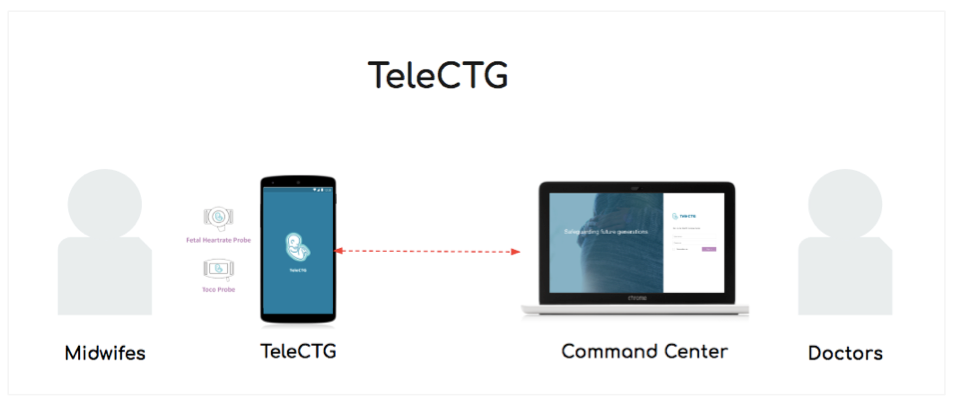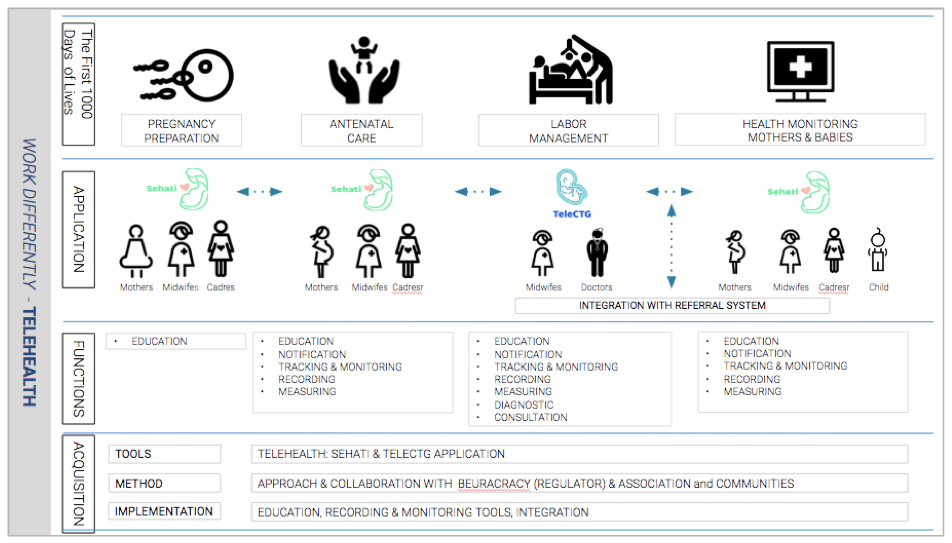Sehati & TeleCTG, offers a different approach through the Telehealth concept to achieve our objective of promoting equal opportunities for healthcare services through technology, knowledge, and people empowerment.
This initiative starts from a strong desire and passion to participate in improving the quality of Indonesia’s human resources. High-quality human resources play an important role in ensuring a nation’s sovereignty. Currently, Indonesia’s Human Development Index (HDI) dropped, we rank 113 out of 188 countries. From a population of about 262 million, approximately 140 million live without an income of IDR 20.000 (USD 1.50) per day while 19.4 million people suffer from malnutrition (UNDP 2015: Human Development Report). With the knowledge and experiences of more than 12 years in maternal and women’s healthcare, we want to contribute and participate through technology empowerment in the First 1,000 Days of Life. We lay out the ecosystem to facilitate wider promotion and preventive healthcare service delivery through information, education, and people empowerment using technology. We collaborate with regulators, doctors (specialists), for the command center, and develop mothers and midwifery communities empowered by Ibu Sehati and Bidan Sehati Application, as well as telemedicine-based medical device, TeleCTG, to assist in diagnosing fetal wellbeing and distress under one database platform for better Antenatal Care, as well as labor management process tracking and monitoring.

Figure 1 – Flow of TeleCTG.
An archipelago with 16,056 geographically-scattered islands, Indonesia has 5.4 million pregnancies each year (1.7 percent growth per year), Of 4,136 ObGyn, 61 percent reside in Java Island. Such conditions result in limited access to doctors, transportation, and medical devices, while Antenatal Care (ANC) as well as labor management is crucial during the first nine months since this time period shapes the rest of your life. The implementation of the Indonesian National Health Insurance System (BPJS) in 2014 shifts the healthcare delivery game in Indonesia. Aiming for 95 percent coverage by the year 2019, the healthcare delivery is structured into stages and primary care is provided in community healthcare centers (PUSKESMAS) or clinics with midwives and General Practitioners (GP) as the providers. Such conditions put midwives in a focal role since they become the front line for maternal and children’s healthcare. However, the majority of midwives in Indonesia are only equipped with vocational education (diploma degrees) and in many cases, the implementation of BPJS reduces the incomes of midwives.
Having such a big role in the maternal healthcare system, we came up with Bidan Sehati Application to support midwives in performing their work through its features. It assists midwives in providing information to pregnant mothers, recording and monitoring the 40 weeks of pregnancy using three parameters set in the application, detecting fetal distress, and performing labor management through TeleCTG application and e-partograph that are embedded in Bidan Sehati Application. TeleCTG enables midwives to directly consult with ObGyn specialists in the Command Center during fetal wellbeing is monitoring that we hope can assist in the referral to more advanced healthcare facilities and timely performance. As a product of Indonesia, TeleCTG is more affordable, portable, and accessible. The three sensors (toco, fetal heartrate, and movement) are connected to the TeleCTG cube that sends digital data from a smartphone via bluetooth to the application in the Command Center. Compact, TeleCTG is easily operated in remote areas as long as an internet network is present which enables midwives to perform fetal wellbeing monitoring. Also, in Bidan Sehati application, midwives who already have become members of the community have the opportunity to enhance their competency and knowledge through routine online training, as well as improve their wellbeing, financially, through Bidan Sehati programs.
Receiving appropriate medical care during pregnancy and being informed are also responsibilities of pregnant mothers. Ibu Sehati Application, that is connected with Bidan Sehati Application enables pregnancy to be monitored by both mothers and midwives. Bidan Sehati Application can also be operated with limited access by cadres, civilians, who are assigned to assist midwives. These tools are not only applicable for public-owned healthcare facilities, for private-owned hospitals and clinics, Bidan Sehati Application can be operated by nurses or midwives, while the Command Center can be monitored by a hospitals’ doctors.

Figure 2 – How Sehati & TeleCTG play roles in First 1,000 Days of Lives.
With Sehati Application and TeleCTG, we encourage proactive and preventive measures through early detection of a large number of potential complications that can occur during pregnancy that we identify by setting parameters within the application. It also enables the tracking of medicine adherence by mothers. Midwives are able to monitor pregnancies through the completeness of parameter-related data that needs to be filled. As from TeleCTG, promptness in providing CTG interpretation would help to determine in a timely manner fetal distress conditions, thus enabling a referral to a more advanced healthcare facility. Sehati Application and TeleCTG could also assist in enhancing the competency of midwifes through online and offline updates and training, as well as consultation with an ObGyn.
At the moment, there are a number of applications for mothers and midwives, however they are operated separately, not under one platform and database. The presence of TeleCTG is our solution. We are not only practicing telemedicine through Sehati Application and TeleCTG, but we also empower people -- mothers and midwives through access to information and education. In short, we practice telehealth. The benefit of practicing telemedicine is proven by research conducted from 2007 to 2011 on telemedicine support on maternal and newborn health in remote provinces in Mongolia1. This research concludes that telemedicine is an excellent recourse for providing quality clinical management to women at risk of poor pregnancy outcomes in geographically remote areas and it provides efficient utilization of a network for timely and appropriate care - all which can work to prevent pregnancy-related emergencies. However, telemedicine is only a tool, it cannot replace local health care and only serves as a support and educational mechanism – Successful coordination of all parties is vital for a positive outcome.
Although we are mostly classified as a social entrepreneur, we do not forget the business aspect of our efforts. We want to be financially independent and self-sufficient and for the program to be rolled out without dependency on donations. We strongly believe that our efforts will do good for many people therefore we want to make it into a sustainable business. The funding for our business comes from revenue that we earn through economic activities in our communities, including the sales of TeleCTG as well as its services (SAS approach). In terms of business scaling, besides the economic-value activities in Ibu Sehati and Bidan Sehati communities and applications, TeleCTG is an Indonesian made medical device, and through President Decree no. 6 / 2016, all government owned healthcare facilities are mandated to use it. Presently, there are around 9,800 community health centers, 2,100 hospitals, not to mention clinics and private practices with approximately 400,000 midwives, that currently use TeleCTG. So, in terms of business scalability, this is a lucrative venture.
Author Bio
Sehati Nusantara is the COO and co-founder of TeleCTG International. Sehati has more than 12 years of experience in the healthcare industry and managing hospitals. Together with her husband, Dr. Ari Waluyo, SpOG, who brings more than 14 years of experience as an ObGyn and lecturer on midwifery experience they are focused on their initiative utilizing business principles while also partnering with tech-savvy millennials.
1“Telemedicine Support on Maternal and Newborn Health to remote Provinces of Mongolia,”2007 -2011, Dr. Tsedmaa B, Global Telehealth Conference 2012


